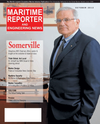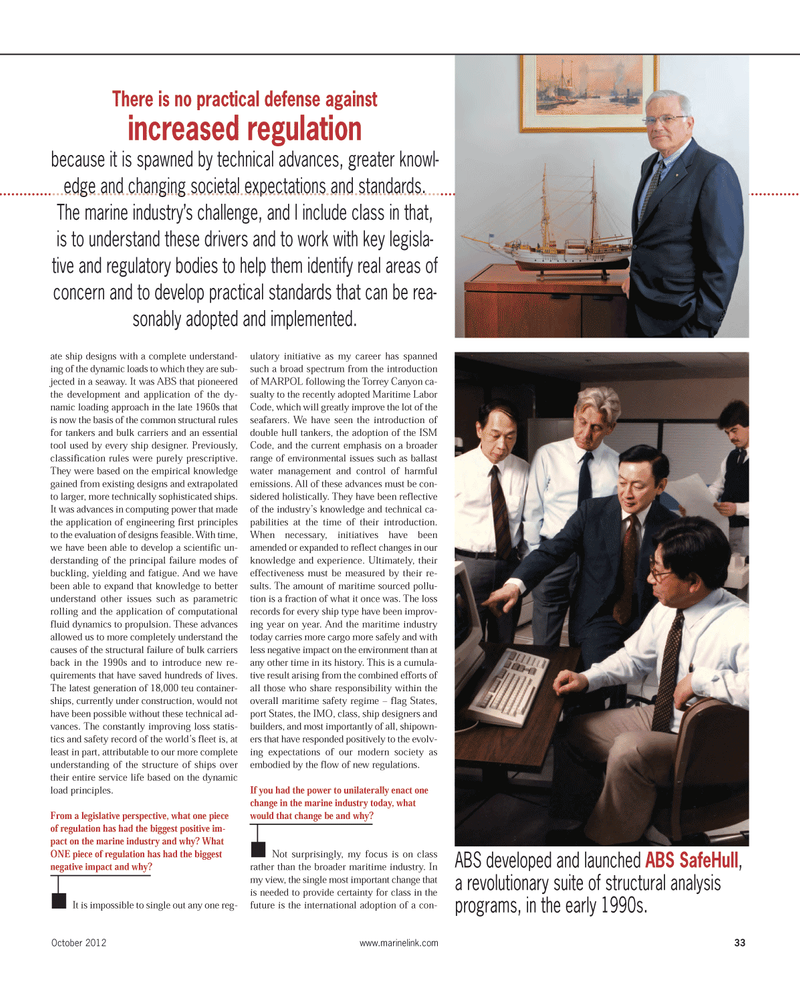
Page 33: of Maritime Reporter Magazine (October 2012)
Marine Design & Construction
Read this page in Pdf, Flash or Html5 edition of October 2012 Maritime Reporter Magazine
October 2012www.marinelink.com 33ABS developed and launched ABS SafeHull,a revolutionary suite of structural analysisprograms, in the early 1990s. ate ship designs with a complete understand- ing of the dynamic loads to which they are sub- jected in a seaway. It was ABS that pioneered the development and application of the dy- namic loading approach in the late 1960s thatis now the basis of the common structural rules for tankers and bulk carriers and an essential tool used by every ship designer. Previously, classification rules were purely prescriptive. They were based on the empirical knowledge gained from existing designs and extrapolated to larger, more technically sophisticated ships. It was advances in computing power that made the application of engineering first principles to the evaluation of designs feasible. With time, we have been able to develop a scientific un- derstanding of the principal failure modes of buckling, yielding and fatigue. And we have been able to expand that knowledge to better understand other issues such as parametricrolling and the application of computationalfluid dynamics to propulsion. These advances allowed us to more completely understand the causes of the structural failure of bulk carriers back in the 1990s and to introduce new re- quirements that have saved hundreds of lives. The latest generation of 18,000 teu container- ships, currently under construction, would not have been possible without these technical ad- vances. The constantly improving loss statis- tics and safety record of the world?s fleet is, at least in part, attributable to our more complete understanding of the structure of ships over their entire service life based on the dynamicload principles. From a legislative perspective, what one piece of regulation has had the biggest positive im- pact on the marine industry and why? What ONE piece of regulation has had the biggest negative impact and why? It is impossible to single out any one reg- ulatory initiative as my career has spanned such a broad spectrum from the introductionof MARPOL following the Torrey Canyon ca- sualty to the recently adopted Maritime LaborCode, which will greatly improve the lot of the seafarers. We have seen the introduction of double hull tankers, the adoption of the ISM Code, and the current emphasis on a broaderrange of environmental issues such as ballast water management and control of harmful emissions. All of these advances must be con- sidered holistically. They have been reflective of the industry?s knowledge and technical ca- pabilities at the time of their introduction.When necessary, initiatives have been amended or expanded to reflect changes in our knowledge and experience. Ultimately, their effectiveness must be measured by their re- sults. The amount of maritime sourced pollu- tion is a fraction of what it once was. The loss records for every ship type have been improv- ing year on year. And the maritime industry today carries more cargo more safely and with less negative impact on the environment than at any other time in its history. This is a cumula- tive result arising from the combined efforts of all those who share responsibility within theoverall maritime safety regime ? flag States, port States, the IMO, class, ship designers andbuilders, and most importantly of all, shipown- ers that have responded positively to the evolv- ing expectations of our modern society as embodied by the flow of new regulations. If you had the power to unilaterally enact one change in the marine industry today, what would that change be and why? Not surprisingly, my focus is on class rather than the broader maritime industry. In my view, the single most important change that is needed to provide certainty for class in the future is the international adoption of a con-There is no practical defense against increased regulation because it is spawned by technical advances, greater knowl- edge and changing societal expectations and standards. The marine industry?s challenge, and I include class in that, is to understand these drivers and to work with key legisla-tive and regulatory bodies to help them identify real areas of concern and to develop practical standards that can be rea- sonably adopted and implemented. MR#10 (26-33):MR Template 9/28/2012 1:31 PM Page 33

 32
32

 34
34
